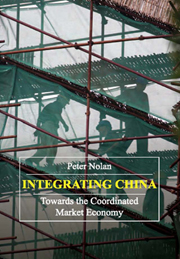Book contents
- Frontmatter
- Contents
- Acknowledgements
- Foreword
- 1 Reflections on 4th June 1989
- 2 The Global Business Revolution and Developing Countries
- 3 The Globalisation Challenge and the Catch-up of Developing Countries: The Case of the Brewing Industry
- 4 The Global Industrial Consolidation and the Challenge for China: The Case of the Steel Industry
- 5 China in the Asian Financial Crisis: ‘Cutting the Trees to Save the Forest’
- 6 China at the Crossroads
- 7 Capitalism and Freedom: The Contradictory Character of Globalisation
- 8 Capitalism, Conflict and Cooperation: US-China Relations under Capitalist Globalisation
- Index
2 - The Global Business Revolution and Developing Countries
Published online by Cambridge University Press: 05 March 2012
- Frontmatter
- Contents
- Acknowledgements
- Foreword
- 1 Reflections on 4th June 1989
- 2 The Global Business Revolution and Developing Countries
- 3 The Globalisation Challenge and the Catch-up of Developing Countries: The Case of the Brewing Industry
- 4 The Global Industrial Consolidation and the Challenge for China: The Case of the Steel Industry
- 5 China in the Asian Financial Crisis: ‘Cutting the Trees to Save the Forest’
- 6 China at the Crossroads
- 7 Capitalism and Freedom: The Contradictory Character of Globalisation
- 8 Capitalism, Conflict and Cooperation: US-China Relations under Capitalist Globalisation
- Index
Summary
Contrasting Views on Globalisation and Industrial Structure
The nature and determinants of industrial structure are among the most important issues in economics. In the history of economics, there have been radically contrasting views on the basic determinants of industrial structure. For most of the twentieth century, industrial structure was heavily influenced by state industrial policy. Since the 1980s, the end of communist central planning and of inward-looking development strategies in poor countries, together with widespread privatisation and liberalisation, ushered in the epoch of ‘globalisation’. This provides an opportunity to test the validity of the competing views of the determinants of industrial structure under free market conditions.
There is a substantial empirical literature analysing the nature and determinants of industrial structure prior to the epoch of modern ‘globalisation’. However, there is still a dearth of empirical analysis of the nature and causes of the trends in industrial structure in the epoch of globalisation, and of the implications of these trends for both theory and policy. The assembly and interpretation of evidence on this issue is critical for understanding the current epoch.
Mainstream View
The ‘mainstream’, ‘neo-classical’ view of the competitive process believes that the perfectly competitive model best describes the essence of capitalist competition. Departures from it are viewed as exceptional and typically arising from government intervention, including protection and nationalisation. At the heart of the mainstream view is the self-equilibrating mechanism of market competition. […]
- Type
- Chapter
- Information
- Integrating ChinaTransition into Global Economy, pp. 19 - 42Publisher: Anthem PressPrint publication year: 2007

